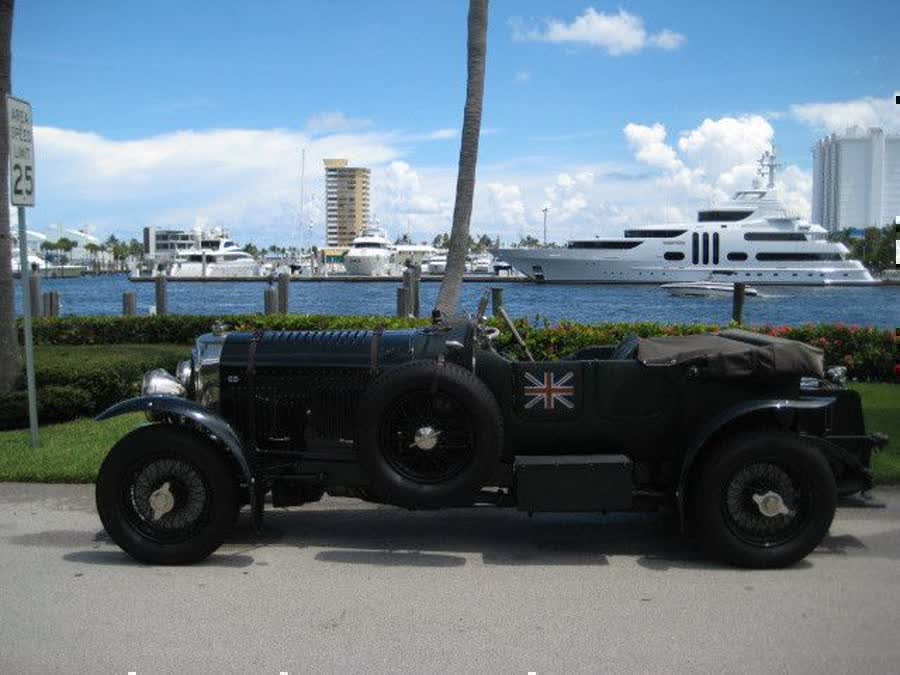
235+ bhp, 4,566 cc supercharged, L-head MK VI inline six-cylinder engine, modified Bentley MK VI four-speed manual gearbox with Laycock/Petersen ‘P’-Type overdrive, strengthened Rolls-Royce 20/25 chassis with front and rear leaf springs, and competition-specification, servo-assisted hydraulic drum brakes, 14" front, 17" rear. Wheelbase: 132" - A remarkable recreation by marque specialist Bob Petersen Engineering in the UK - Based on an original Rolls-Royce 20/25 chassis - One of the six examples built for noted London Bentley dealer Jack Barclay Ltd. - Impressive and period correct, with incredible performance The famous 4.5-liter “Blower” Bentley originated from the vision of Sir Henry Birkin, who was one of the original “Bentley Boys,” as the works racing drivers were widely known. Birkin set out to convince Bentley’s then-Chairman Woolf Barnato that supercharging, in combination with Bentley’s renowned reliability, would yield winning results on the racing circuit and help the marque continue its success at Le Mans. Barnato seemingly agreed, despite W.O. Bentley’s early objections to supercharging. At least 50 examples were required to homologate the new model for competition, and ultimately 55 cars were built, with the majority offered for sale to the public and five going directly into Birkin family ownership. With their high-output supercharged engines, striking leather-clad Vanden Plas bodies and minimalist cycle-type fenders, the new Bentleys exuded power, speed and grand exclusivity, distinctive elements of the Bentley mystique that continues today. Then, as now, the “Blower Bentley" represents without doubt one of the most desirable British cars ever constructed, and as a result, they are the prized possessions of their owners and appear infrequently at public sales. Many have never come to market, remaining locked within the confines of private collections all over the world, where they will likely remain for many years to come. Magnificently crafted and engineered with uncompromising attention to detail and authenticity during the 1990s by English marque specialist Bob Petersen Engineering, the 4.5-liter “Blower Bentley" offered here is an outstanding automobile. One of six examples built for noted London Bentley dealer Jack Barclay Ltd., it is based upon an original Rolls-Royce 20/25 chassis, numbered GHW 56. The frame was stripped, strengthened and stiffened by Petersen, closely adhering to the original Bentley specifications. In addition, new cross-members, suspension mounts and associated fittings were added to accept the new engine and supercharger unit. A drivetrain from a postwar Bentley MK VI donor car was installed, with the engine fully rebuilt, carefully blueprinted and fitted with a special camshaft and pistons, as well as a special flywheel and a Petersen heavy-duty clutch. The front-mounted Petersen BM MK1 supercharger is very similar in appearance and detail to the original Amherst-Villers units originally used on the Bentleys campaigned in period by the Birkin racing team. A 4.5-liter “Blower”-specification radiator contains a heavy-duty core and provides reliable cooling with a mechanical fan, supplemented by an electric fan as required. Gear changes are provided by a postwar Bentley MK VI four-speed manual gearbox, with the addition of a Laycock/Petersen ‘P’-Type overdrive unit on fourth gear, providing ease of operation at sustained high speeds. Ride and handling at speed are enhanced by a set of period-type Hartford adjustable shock absorbers, while braking is supplied by a set of updated servo-assisted hydraulic brakes, with a pair of 14-inch drums with twin leading shoes up front, and a pair of 17-inch drums at the rear. Of course, the Petersen Bentley is fitted with a set of period-style 19-inch, 70-spoke wire wheels, shod with blackwall tires. Equally impressive is the handsome Vanden Plas-style open coachwork, which was hand-built and executed with remarkable similarity to factory-original specifications, utilizing fabric-covered aluminum panels over ash framing, with the period correct three-door touring body configuration. Wonderful details abound in the cockpit as well, including the rich Connolly leather upholstery and green Wilton wool carpeting, while a black double duck top and a matching tonneau cover provide protection from the elements. The dash, which is made of machine-turned aluminum, is fitted with a set of large, aircraft-type instruments and was produced specifically for Petersen Engineering, patterned after that of the original Birkin team cars. Appropriately finished in British Racing Green, the car includes an incredible level of detail, with numerous fittings authentically reproduced by Bob Petersen Engineering, including the filler caps, stone guards, footplates, fuel tank, radiator, wheels, hubs and many smaller items. Many period features complement this “Blower Bentley,” including dual Lucas headlamps, dual cowl lamps and a folding windscreen with dual “Brooklands” racing windscreens, as well as a side-mounted spare wheel and tire assembly. With the glorious whine of its front-mounted supercharger and a raucous exhaust note announcing its 235-plus horsepower output, this “Blower Bentley” offers performance levels and open-air driving excitement that are nothing short of breathtaking. Complete with its postwar MK VI drivetrain, upgraded hydraulic brakes and overdrive, this car is substantially more comfortable, not to mention safer and easier to drive, than the legendary, priceless and virtually unobtainable originals. Worthy of taking pride of place in any collector’s stable of the finest British high-performance automobiles, this “Blower” will certainly provide a much-needed break from the ordinary for its next owner. Please note, the car is titled as a “1932 Bentley,” with the serial number 1016 marked on the firewall plate. SOLD , GOING TO FRANCE !! MERCI STEPHANE !!
http://www.victorycars.com/inventory_details.asp?offset=12&InventoryNum=979
No comments:
Post a Comment